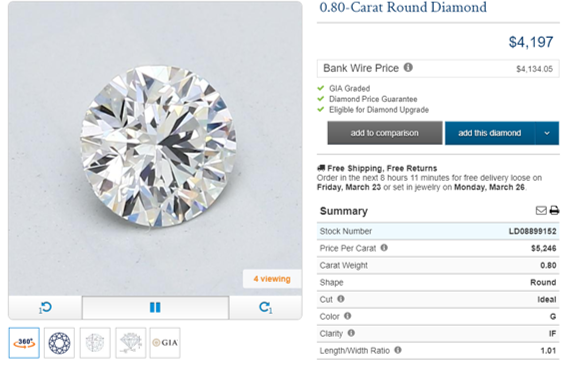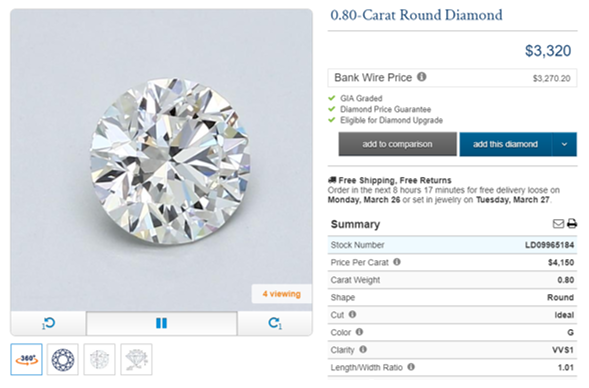This page contains references to diamonds or engagement rings from different companies. Sometimes I do receive a commission when you click on links and buy the products.
In the world of diamonds, VVS is a diamond clarity grade that is divided into two subsections: VVS1 and VVS2. The acronym stands for ‘very very slightly included’, while the numbers further scrutinize the clarity of the stone, with a VVS1 denoting a slightly higher clarity grade than a VVS2.
Clarity grades are determined by the amount of inclusions or natural deposits within the diamonds and the blemishes or scratches on the surface of the diamond.
VVS Clarity Grading
The clarity grading system for diamonds is shown on a scale:

Image courtesy of Whiteflash
In order to be graded, a diamond must undergo a stringent process of analysis, both by eye and under a 10x magnification microscope. The diamond is viewed from every angle. Darkfield lighting is used to reveal certain characteristics, while strong overhead lighting helps to assess whether inclusions rest on the surface of the stone or internally. The expert may use the microscope to zoom in on particular inclusions to determine what they are (cloud, crystal, feather, and so on) but the final grade will be determined at a 10x magnification only.
Understanding the process of clarity grading also highlights the importance of having a diamond assessed by a leading institute. The above process would be a minimum requirement for laboratories such as the GIA or AGL, however, lesser establishments have been known to grade their diamonds in normal light by simply using a 10x magnification loupe.
Although a professional will be able to ascertain certain characteristics by eye and by using a jeweler’s loupe, the only way to get a clear and definitive result is by using specialized lighting and equipment.
Inclusions are barely visible under 10x magnification—and that’s when it’s being evaluated by a trained professional. Even then, it generally takes ample time for a trained eye to locate the imperfections. If you’re looking for the best-of-the-best VVS diamonds consider the A CUT ABOVE® Collection Series from Whiteflash – these are the highest Colorless IF-VVS Super Ideals available.
VVS Diamonds Price Comparison
Although technically a lower grade than an IF or FL diamond, the VVS stone offers the same beauty and flawless appearance when viewed by the eye. Only professionals with a 10X loupe will be able to determine the difference between a flawless diamond and a VVS diamond.
Although they give much the same visual beauty as a flawless diamond, a VVS stone will carry a much lower price tag.
I have used Blue Nile to compare the prices of a VVS1 diamond and an IF diamond. Both carry the same color, carat, and cut grading.
Round Brilliant – 0.80ct G-VVS1 Ideal Cut – $3,320
Round Brilliant – 0.80ct G-IF Ideal Cut – $4,197

There is a price difference of $877, but you will also notice that the price per carat has also increased by $1,096.
It is worth mentioning that I was unable to compare the price of a VVS1 diamond with an FL diamond. Despite the huge inventory that Blue Nile offers, flawless diamonds are extremely rare. This is another reason many people will opt for a VVS stone. It can be very difficult to find a flawless diamond that also meets your requirements for color, carat, and cut.
Where to Buy VVS Diamonds
A VVS diamond is a thing of beauty. These stones are usually completely eye-clean, meaning they give the spectacular visual impact of a flawless stone, but without the huge price increase.
Whether online or in a jewelry store, be sure to opt for a GIA or AGS certified diamond to ensure the grading is a true VVS and make sure they provide light performance images. Here is a chart of the top vendors and the information that they provide:
| Whiteflash | Blue Nile | James Allen | Brilliant Earth | Ritani | |
|---|---|---|---|---|---|
| HD Video Imaging |
✓(Brilliance and Sparkle Video) |
✓ |
✓ |
✕ |
✓(only on request) |
| Diamond Image |
✓ |
✕ |
✕ |
✕ |
✓(only on request) |
| Ideal Scope |
✓ |
✕ |
✕ |
✕ |
✕ |
| Hearts & Arrows |
✓ |
✕ |
✕(only on some diamonds) |
✕ |
✕ |
| Sarine Report |
✓ |
✕ |
✕ |
✕ |
✕ |
| ASET Map |
✓ |
✕ |
✕ |
✕ |
✕ |
Final Thoughts
VVS diamonds, encompassing both VVS1 and VVS2 grades, represent a pinnacle of clarity in the diamond world. These diamonds, with their minute inclusions that are barely discernible even under 10x magnification, offer a near-flawless appearance to the naked eye. This makes them a popular choice for those seeking the brilliance of a flawless diamond without the accompanying price tag.
The meticulous grading process, especially when conducted by reputable institutions like the GIA (or AGSL), ensures that buyers receive an accurate representation of the diamond’s clarity. This underscores the importance of purchasing diamonds that have been assessed using specialized lighting and equipment, rather than relying solely on a jeweler’s loupe.
Price comparisons reveal that VVS diamonds provide a cost-effective alternative to IF or FL diamonds, offering similar visual appeal at a reduced cost. However, it’s crucial for potential buyers to ensure they’re purchasing from vendors that provide comprehensive information, including HD video imaging, diamond images, and other essential reports.
Whether you’re considering a VVS diamond or another grade, the key is to prioritize certified diamonds and make informed decisions based on both the diamond’s characteristics and your personal preferences.

Richard Jenkins, The Diamond Guru
Get free assistance from the Diamond Guru today. You’ll be glad you did!
- Secure the best quality diamond for your budget.
- Don’t pay over the odds for your diamond ring.
- Have peace of mind that you didn’t get ripped off.
Have a Question? Contact us now…


